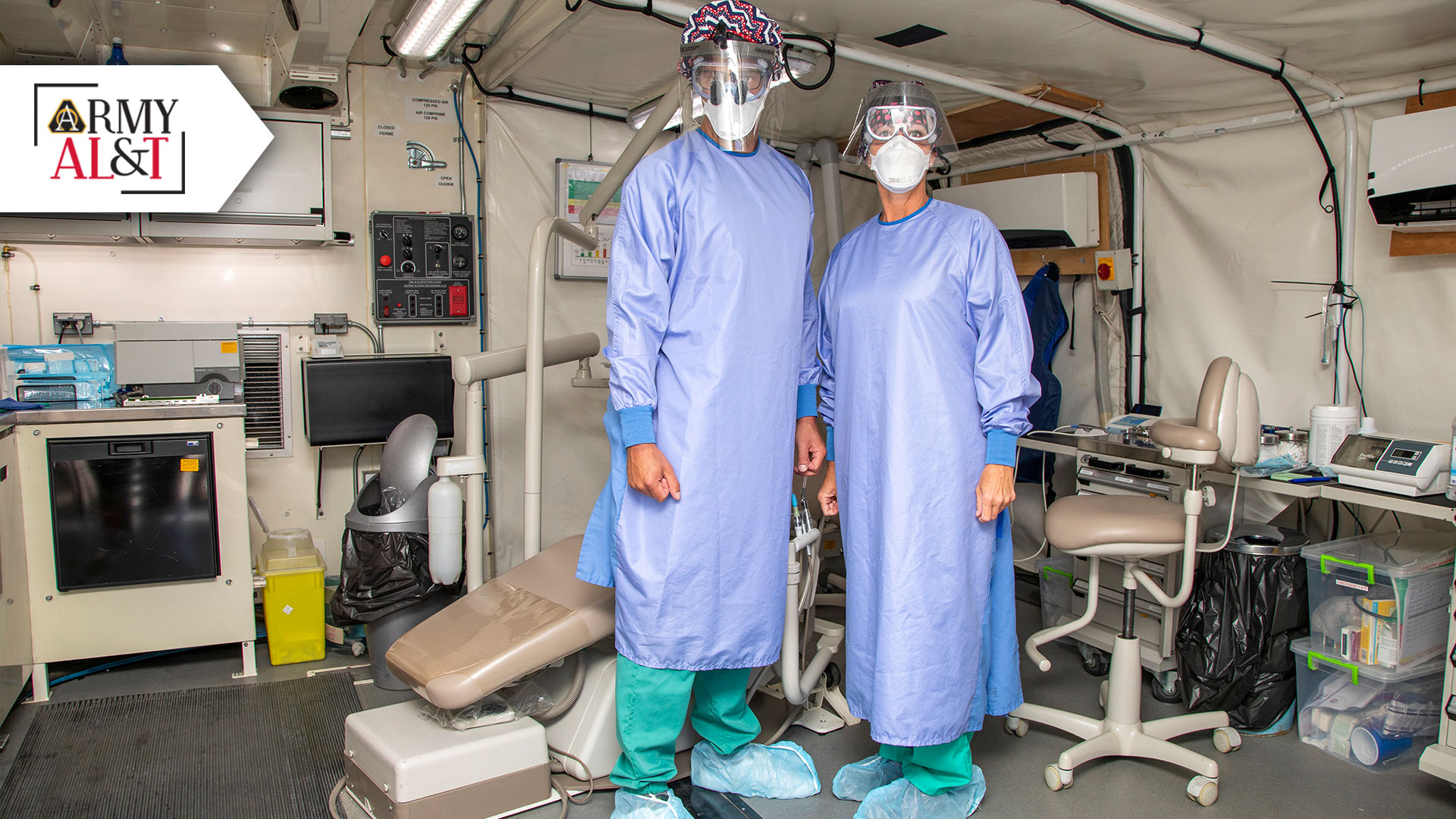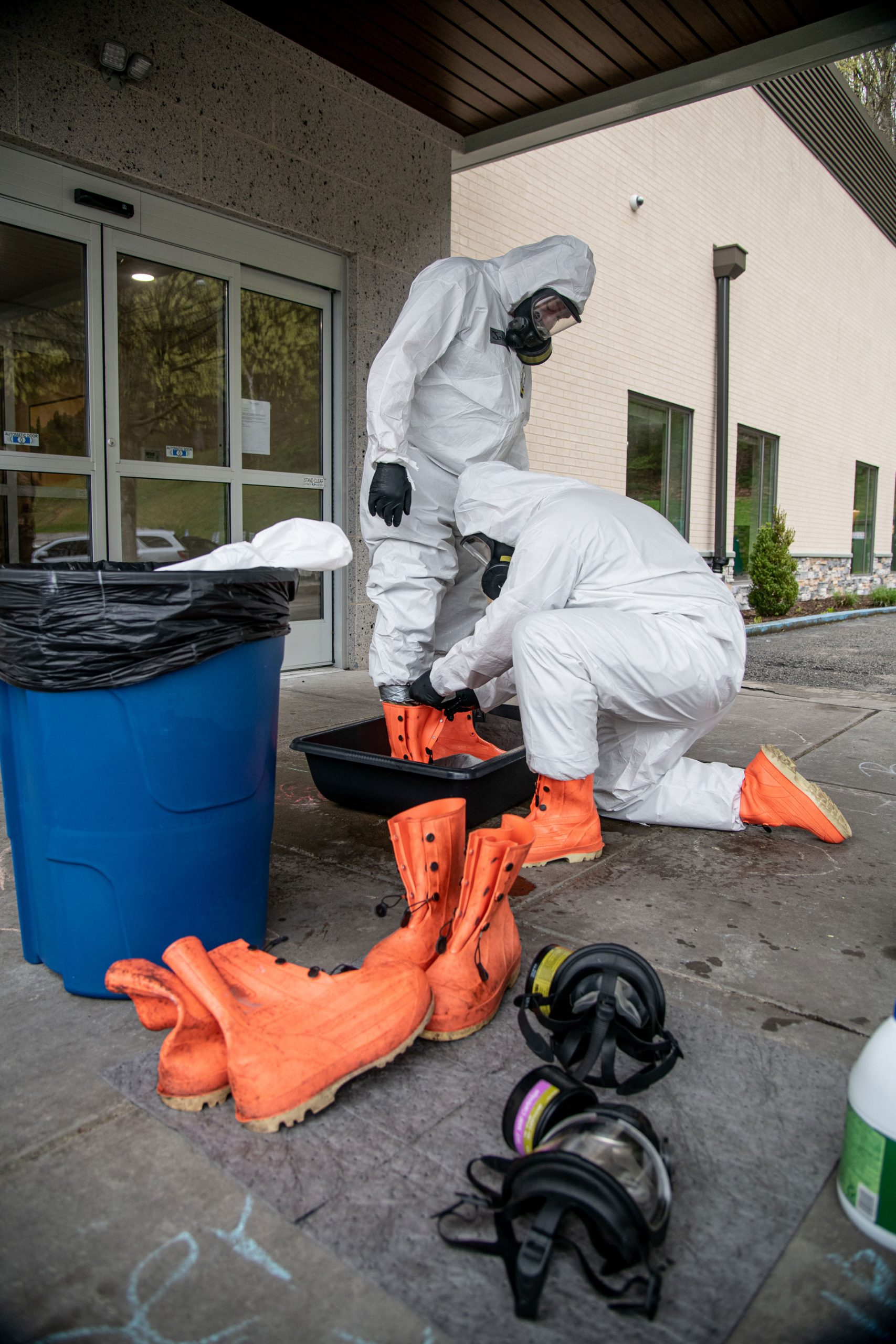
THE WHOLE KIT AND CABOODLE: The team was tasked to award contracts for things like KN95 respirators, face shields, nitrile gloves, shoe covers, and surgical caps, gowns and masks—similar to the ones worn here by Canadian Army Capt. Zack Zeiler, a dentist, left, and Master Cpl. Carla MacNeil, a dental technician, in April at Erbil Air Base in the Kurdistan Region of Iraq. (Photo by Spc. Angel Ruszkiewicz, Combined Joint Task Force, Operation Inherent Resolve)
The pandemic’s culture change switched the focus from a normal workload to getting the PPE out the door.
by Rachel Porto and Adam Lowe
Tom Kloehn has had a few more responsibilities than usual, thanks to the COVID-19 pandemic.
His normal day-to-day routine was quickly shelved when the Army asked his team to provide what seemingly the entire world needed: personal protective equipment (PPE). As it happened, Kloehn’s team was tasked with working with Army Contracting Command (ACC), General Services Administration (GSA) and the Defense Logistics Agency (DLA) to award contracts for KN95 respirators, face shields, nitrile gloves, hand sanitizers, eye protection, biohazard bags and combat face coverings, as well as thermometers, shoe covers, surgical caps, surgical gowns and surgical masks. “[The U.S. Department of] Health and Human Services and DOD entities would say to us, ‘We have X amount of dollars for PPE; how can we get the biggest bang for our buck?’ So our team would start strategizing by seeing what’s on the market and what’s the fastest and cheapest way we can get this out to the Soldiers who need it,” said Kloehn.
THE BIG SHIFT
Kloehn normally leads a product management team, working on programs of record that focus on protecting the Joint Services against chemical, biological, radiological and nuclear (CBRN) threats via mass personnel contamination mitigation systems. His team has also worked on the development of a transfer case that can protect mortuary affairs Soldiers and air crew members from contamination as they work to repatriate the remains of an Airman, Sailor, Soldier, Marine or military dependent who died in a CBRN-contaminated environment while outside the continental U.S. It’s the type of 9-to-5 job that most high school guidance counselors don’t often talk about. Despite the unsung nature of the job, Kloehn takes great satisfaction knowing his team provides a capability to the warfighter that not only protects them from harm, but allows them to continue and complete their mission in a potentially dangerous environment.
But at the beginning of the pandemic, Kloehn was asked to do something a little outside of his wheelhouse. So his team pivoted from its usual CBRN protection procurement and dug through regulatory and technical requirements and, together with ACC, got the PPE contracts together at much quicker speeds, reducing the timeline dramatically, despite no one physically being in the office. The timeline from requirements identification to contract award would typically take around 30 days for procurements similar to these; however, contracts were being executed in less than five. Once other agencies and organizations realized how quickly his team procured these PPE, they approached Kloehn and his teammates for help.
A lot of research went into determining which contract vehicles would work best to help procure the most PPE at the best price. “The market research team, led by Chuck Nuce, was a big part of this,” Kloehn explained. “In the beginning, it wasn’t just strategizing on what contract vehicle it was going on. The very first piece of this was figuring out, 1) Who has this, 2) Who has the amount we need, and 3) Can they get it to us in less than 30 days?” That team made calls, sent emails, pounded virtual pavement and would then come back to the larger team with a formal report.
Whether the team was procuring PPE with funds from the Joint Program Executive Office for Chemical, Biological, Radiological and Nuclear Defense (JPEO-CBRND) or from other organizations, Kloehn was involved with the whole process—from researching and choosing vendors to collaborating heavily on the delivery side with the Army’s Tank-automotive and Armaments Command and then processing final payment with the vendors. While the acquisition process is typically slow, these contracting drills for acquiring PPE have been rapid-paced. Because of his team’s dedication and willingness to work extended hours to complete the mission, it was able to turn around proposal reviews within 48 hours, typically unheard of in normal circumstances.
There were many restrictions the team encountered when procuring not just the PPE but also the waivers that would need to be applied to make the PPE acquisitions possible. Because some of these products are made outside of the U.S., Kloehn and his team needed waivers for the Berry Amendment, which says certain textiles and fabrics must be U.S. made, as well as waivers for the Buy America Agreement and the Trade Agreement Act. This meant they had to do a lot of regulatory work in order to understand what was possible and what was not, had to bring in lawyers to learn the nuances of the regulations, and needed to work with the highest levels of the Office of the Secretary of the Army in order to determine how to handle these roadblocks and decide when to push some of items to DLA because they weren’t able to find a workaround. “Again, this was far outside the scope of the work we typically do in non-pandemic circumstances, so it was a lot of learning and growing on our end, and even we were surprised by some of the things we learned along the way,” said Kloehn. For example, when procuring basic PPE, even when it’s intended for non-medical use (like walking around outside), it still has to adhere to medical regulatory requirements. This led to rejecting some already-procured items, but it also got the team smarter on what was expected from U.S. Army Medical Research and Development Command on all these PPE items.

PPE IN A HURRY: Tom Kloehn and his team assembled PPE contracts at much quicker speeds than normal, despite no one physically being in the office. The timeline went from around 30 days to less than five. (Photo by Edwin L. Wriston, West Virginia National Guard)
BUILDING THE TEAM
Tom Kloehn does what he can to provide mentorship to every member of his team, and explains that taking advantages outside of normal swim lanes can be a benefit to anyone’s professional career. “This not only allows for junior personnel to develop new skills and abilities, it can also highlight adverse qualities that may not provide value as a leader in the acquisition workforce. Our team’s COVID-19 PPE efforts are a great example. Our lead test analyst is the primary lead for communicating with all of the PPE vendors and submitting all regulatory approval requests, while our lead program analyst is coordinating the receipt, inspection and acceptance of all material at the Army warehouse,” said Kloehn. “Both of them are working way outside of their normal roles but definitely knocking it out of the park.”
“Even when our efforts shifted, my team continued to pull together and went above and beyond to make sure we could complete the mission and help get the warfighter the items they needed,” said Kloehn.
CONCLUSION
Kloehn and his team will undoubtedly return to their core mission when the pandemic subsides—the need for mass decontamination systems and human remains transfer cases haven’t gone anywhere—but not before taking a lot of the lessons learned with them. “This effort proved that when working with contracting and industry, we can do things a lot faster when we put our minds to it,” he said. “That’s been a huge takeaway and I hope it continues. I don’t need to commute two hours to get this job done.”
For more information on JPEO-CBRND’s roles in the COVID-19 response, visit https://www.jpeocbrnd.osd.mil/coronavirus.
RACHEL PORTO is a contractor with Kalman and Company Inc. supporting the JPEO-CBRND Strategic Communications Office. Before working with the JPEO-CBRND, she supported various defense efforts as a technical writer and editor. Porto holds an M.S. in professional writing with an emphasis in journalism from Towson University and a B.A. in psychology from the University of Maryland, Baltimore County.
ADAM LOWE is a contractor with Booz Allen Hamilton, supporting the JPEO-CBRND as their acting public affairs officer. Before working at Booz Allen Hamilton, he worked various public affairs jobs at a national security think tank and mental health nonprofits. Lowe holds an M.S. from the University of Maryland’s School of Public Health and a B.S. and B.A. from James Madison University.
Read the full article in the Spring 2021 issue of Army AL&T magazine.
Subscribe to Army AL&T – the premier source of Army acquisition news and information.
![]()







